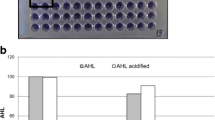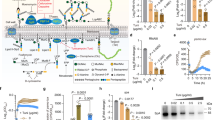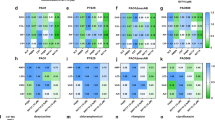Abstract
Virulence pathways in gram-negative pathogenic bacteria are regulated by quorum sensing mechanisms, through the production and sensing of N-acylhomoserine lactone (AHL) signal molecules. Enzymatic degradation of AHLs leading to attenuation of virulence (quorum quenching) could pave the way for the development of new antibacterials. Penicillin V acylases (PVAs) belong to the Ntn hydrolase superfamily, together with AHL acylases. PVAs are exploited widely in the pharmaceutical industry, but their role in the natural physiology of their native microbes is not clearly understood. This report details the characterization of AHL degradation activity by homotetrameric PVAs from two gram-negative plant pathogenic bacteria, Pectobacterium atrosepticum (PaPVA) and Agrobacterium tumefaciens (AtPVA). Both the PVAs exhibited substrate specificity for degrading long-chain AHLs. Exogenous addition of these enzymes into Pseudomonas aeruginosa greatly diminished the production of elastase and pyocyanin and biofilm formation and increased the survival rate in an insect model of acute infection. Subtle structural differences in the PVA active site that regulate specificity for acyl chain length have been characterized, which could reflect the evolution of AHL-degrading acylases in relation to the environment of the bacteria that produce them and also provide strategies for enzyme engineering. The potential for using these enzymes as therapeutic agents in clinical applications and a few ideas about their possible significance in microbial physiology have also been discussed.







Similar content being viewed by others
References
Ahlgren NA, Harwood CS, Schaefer AL, Giraud E, Greenberg EP (2011) Aryl-homoserine lactone quorum sensing in stem-nodulating photosynthetic bradyrhizobia. Proc Nat Acad Sci 108:7183–7188
Avinash VS, Panigrahi P, Suresh CG, Pundle AV, Ramasamy S (2016a) Structural analysis of a penicillin V acylase from Pectobacterium atrosepticum confirms the involvement of two Trp residues for activity and specificity. J Struct Biol 193:85–94
Avinash VS, Pundle AV, Suresh CG, Ramasamy S (2016b) Penicillin acylases revisited: importance beyond their industrial utility. Crit Rev Biotechnol 36:303–316
Avinash VS, Ramasamy S, Suresh CG, Pundle AV (2015) Penicillin V acylase from Petcobacterium atrosepticum shows high specific activity and unique kinetics. Int J Biol Macromol 79:1–7
Arroyo M, de la Mata I, Acebal C, Castillon MP (2003) Biotechnological applications of penicillin acylases, state-of-the-art. Appl Microbiol Biotechnol 60:507–514
Beeton ML, Alves DR, Enright MC, Jenkins ATA (2015) Assessing phage therapy against Pseudomonas aeruginosa using a Galleria mellonella infection model. Int J Antimicrob Agents 46:196–200
Bokhove M, Jimenez PN, Quax WJ, Dijkstra BW (2010) The quorum-quenching N-acyl homoserine lactone acylase PvdQ is an Ntn N-hydrolase with an unusual substrate-binding pocket. Proc Nat Acad Sci 107:686–691
Carlier A, Uroz S, Smadja B, Fray R, Latour X, Dessaux Y, Faure D (2003) The Ti plasmid of Agrobacterium tumefaciens harbors an attM paralogous gene, aiiB, also encoding N-acyl homoserine lactonase activity. Appl Environ Microbiol 69:4989–4993
Chand D, Varshney NK, Ramasamy S, Panigrahi P, Brannigan JA, Wilkinson AJ, Suresh CG (2015) Structure mediation in substrate binding and post-translational processing of penicillin acylases: information from mutant structures of Kluyvera citrophila penicillin G acylase. Prot Sci 24:1660–1670
Chow JY, Yang Y, Tay SB, Chua KL, Yew WS (2014) Disruption of biofilm formation by the human pathogen Acinetobacter baumannii using engineered quorum-quenching lactonases. Antimicrob Agents Chemother 58:1802–1805
Churchill ME, Chen L (2011) Structural basis of acyl-homoserine lactone-dependent signaling. Chem Rev 111:68–85
Cooley MA, Whittall C, Rolph MS (2010) Pseudomonas signal molecule 3-oxo-C12-homoserine lactone interferes with binding of rosiglitazone to human PPARgamma. Microbes Infect 12:231–237
De Kievit TR, Gillis R, Marx S, Brown C, Iglewski BH (2001) Quorum-sensing genes in Pseudomonas aeruginosa biofilms: their role and expression patterns. Appl Environ Microbiol 67:1865–1873
Dong YH, Wang LY, Zhang LH (2007) Quorum-quenching microbial infections: mechanisms and implications. Philos Trans R Soc Lond Ser B Biol Sci 362:1201–1211
Essar DW, Eberly L, Hadero A, Crawford IP (1990) Identification and characterization of genes for a 2nd anthranilate synthase in Pseudomonas aeruginosa: interchangeability of the 2 anthranilate synthases and evolutionary implications. J Bacteriol 172:884–900
Evans P (2006) Scaling and assessment of data quality. Acta Crystallogr D 62:72–82
Grandclément C, Tanniéres M, Morera S, Dessaux Y, Faure D (2016) Quorum quenching: role in nature and applied developments. FEMS Microbiol Rev 40:86–116
Ivanova K, Fernandes MM, Francesko A, Mendoza E, Guezguez J, Burnet M, Tzanov T (2015) Quorum quenching and matrix-degrading enzymes in multilayer coatings synergistically prevent bacterial biofilm formation on urinary catheters. ACS Appl Mater Interfaces 7:27066–27077
Jander G, Rahme LG, Ausubel FM (2000) Positive correlation between virulence of Pseudomonas aeruginosa mutants in mice and insects. J Bacteriol 182:3843–3845
Kabsch W (2010) XDS. Acta Crystallogr D 66:125–132
Koch G, Nadal-Jimenez P, Reis CR, Muntendam R, Bokhove M, Melillo E, Dijkstra BW, Cool RH, Quax WJ (2014a) Reducing virulence of the human pathogen Burkholderia by altering the substrate specificity of the quorum-quenching acylase PvdQ. Proc Nat Acad Sci 111:1568–1573
Koch G, Nadal-Jimenez P, Cool RH, Quax WJ (2014b) Assessing Pseudomonas virulence with nonmammalian host: Galleria mellonella. In:Pseudomonas Methods and Protocols, pp 681–688
Kovacikova G, Lin W, Skorupski K (2003) The virulence activator AphA links quorum sensing to pathogenesis and physiology in Vibrio cholerae by repressing the expression of a penicillin amidase gene on the small chromosome. J Bacteriol 185:4825–4836
Krzeslak J, Wahjudi M, Quax WJ (2007) Quorum quenching acylases in Pseudomonas aeruginosa. In: Ramos JL, Filloux A (eds) Pseudomonas. Springer, New York, pp. 429–449
Kumar RS, Brannigan JA, Prabhune AA, Pundle AV, Dodson GG, Dodson EJ, Suresh CG (2006) Structural and functional analysis of a conjugated bile salt hydrolase from Bifidobacterium longum reveals an evolutionary relationship with penicillin V acylase. J Biol Chem 281:32516–32525
Li YH, Tian X (2012) Quorum sensing and bacterial social interactions in biofilms. Sensors 12:2519–2538
Li Z, Nair SK (2012) Quorum sensing: how bacteria can coordinate activity and synchronize their response to external signals. Prot Sci 21:1403–1417
Lin YH, Xu JL, Hu JY, Wang LH, Ong SL, Leadbetter JR, Zhang LH (2003) Acyl-homoserine lactone acylase from Ralstonia strain XJ12B represents a novel and potent class of quorum-quenching enzymes. Mol Microbiol 47:849–860
Liu D, Thomas PW, Momb J, Hoang QQ, Petsko GA, Ringe D, Fast W (2007) Structure and specificity of a quorum-quenching lactonase (AiiB) from Agrobacterium tumefaciens. Biochemist 46:11789–11799
McClean KH, Winson MK, Fish L, Taylor A, Chhabra SR, Camara M, Daykin M, Lamb JH, Swift S, Bycroft BW, Stewart GS, Williams P (1997) Quorum sensing and Chromobacterium violaceum: exploitation of violacein production and inhibition for the detection of N-acylhomoserine lactones. Microbiol 143:3703–3711
McCoy AJ, Grosse-Kunstleve RW, Adams PD, Winn MD, Storoni LC, Read RJ (2007) Phaser crystallographic software. J Appl Crystallogr 40:658–674
Merritt JH, Kadouri DE, O’Toole GA (2005) Growing and analyzing static biofilms. In: Current protocols in microbiology, pp1B-1
Miyari S, Tateda K, Fuse ET, Ueda C, Saito H, Takabatake T, Ishii Y, Horikawa M, Ishiguro M, Standiford TJ, Yamaguchi K (2006) Immunization with 3-oxododecanoyl-L-homoserine lactone-protein conjugate protects mice from lethal Pseudomonas aeruginosa lung infection. J Med Microbiol 55:1381–1387
Morohoshi T, Nakazawa S, Ebata A, Kato N, Ikeda T (2008) Identification and characterization of N-acylhomoserine lactone- acylase from the fish intestinal Shewanella sp. strain MIB015. Biosci Biotechnol Biochem 72:1887–1893
Mukherji R, Varshney NK, Panigrahi P, Suresh CG, Prabhune A (2014) A new role for penicillin acylases: degradation of acyl homoserine lactone quorum sensing signals by Kluyvera citrophila penicillin G acylase. Enzym Microb Technol 56:1–7
Ochiai S, Yasumoto S, Morohoshi T, Ikeda T (2014) AmiE, a novel N-acylhomoserine lactone acylase belonging to the amidase family, from the activated-sludge isolate Acinetobacter sp. strain Ooi24. Appl Environ Microbiol 80:6919–6925
Ohman DE, Cryz SJ, Iglewski BH (1980) Isolation and characterization of Pseudomonas aeruginosa PAO mutant that produces altered elastase. J Bacteriol 142:836–842
Oinonen C, Rouvinen J (2000) Structural comparison of Ntn-hydrolases. Prot Sci 9:2329–2337
Panigrahi P, Sule M, Sharma R, Ramasamy S, Suresh CG (2014) An improved method for specificity annotation shows a distinct evolutionary divergence among the microbial enzymes of the cholylglycine hydrolase family. Microbiol 160:1162–1174
Papaioannou E, Wahjudi M, Nadal-Jimenez P, Koch G, Setroikromo R, Quax WJ (2009) Quorum-quenching acylase reduces the virulence of Pseudomonas aeruginosa in a Caenorhabditis elegans infection model. Antimicrob Agents Chemother 53:4891–4897
Papaioannou E, Utari PD, Quax WJ (2013) Choosing an appropriate infection model to study quorum sensing inhibition in Pseudomonas infections. Int J Mol Sci 14:19309–19340
Park SY, Kang HO, Jang HS, Lee JK, Koo BT, Yum DY (2005) Identification of extracellular N-acylhomoserine lactone acylase from a Streptomyces sp. and its application to quorum quenching. Appl Environ Microbiol 71:2632–2641
Roche DM, Byers JT, Smith DS, Glansdorp FG, Spring DR, Welch M (2004) Communications blackout? Do N-acylhomoserinelactone-degrading enzymes have any role in quorum sensing? Microbiol 150:2023–2028
Rutherford ST, Bassler BL (2012) Bacterial quorum sensing: its role in virulence and possibilities for its control. Cold Spring Harb Perspect Med 2:a012427
Shewale GJ, Kumar KK, Ambekar GR (1987) Evaluation of determination of 6-aminopenicillanic acid by p-dimethyl aminobenzaldehyde. Biotechnol Tech 1:69–72
Shewale JG, Sudhakaran VK (1997) Penicillin V acylase: its potential in the production of 6-aminopenicillanic acid. Enzym Microb Technol 20:402–410
Steindler L, Venturi V (2007) Detection of quorum sensing N-acyl homoserine lactone signal molecules with bacterial biosensors. FEMS Microbiol Lett 266:1–9
Swift S, Karlyshev AV, Fish L, Durant EL, Winson MK, Chhabra SR, Williams P, Macintyre S, Stewart GS (1997) Quorum sensing in Aeromonas hydrophila and Aeromonas salmonicida: identification of the LuxRI homologs AhyRI and AsaRI and their cognate N-acylhomoserine lactone signal molecules. J Bacteriol 179:5271–5281
Torres-Bacete J, Hormigo D, Torrez-Guzman R, Arroyo M, Castillon MP, Garcia JL, Acebal C, de la Mata I (2015) Overexpression of penicillin V acylase from Streptomyces lavendulae and elucidation of its catalytic residues. Appl Environ Microbiol 81:1225–1233
Uroz S, Dessaux Y, Oger P (2009) Quorum sensing and quorum quenching: the yin and yang of bacterial communication. Chembiochem 10:205–216
Uroz S, Oger PM, Chapelle E, Adeline MT, Faure D, Dessaux Y (2008) A Rhodococcus qsdA-encoded enzyme defines a novel class of large-spectrum quorum-quenching lactonases. Appl Environ Microbiol 74:1357–1366
Wahjudi M, Murugappan S, van Merkerk R, Eissens AC, Visser MR, Hinrichs WLJ, Quax WJ (2013) Development of a dry, stable and inhalable acyl-homoserine-lactone-acylase powder formulation for the treatment of pulmonary Pseudomonas aeruginosa infections. Eur J Pharma Sci 48:637–643
Wahjudi M, Papaioannou E, Hendrawati O, van Assen AHG, van Merkerk R, Cool RH, Poelarends GJ, Quax WJ (2011) PA0305 of Pseudomonas aeruginosa is a quorum quenching acylhomoserine lactone acylase belonging to the Ntn hydrolase superfamily. Microbiol 157:2042–2055
White CE, Finan TM (2009) Quorum quenching in agrobacterium tumefaciens: chance or necessity? J Bacteriol 191:1123–1125
Whitehead NA, Barnard AM, Slater H, Simpson NJ, Salmond GP (2001) Quorum sensing in gram-negative bacteria. FEMS Microbiol Rev 25:365–404
Winson MK, Swift S, Fish L, Throup JP, Jorgensen F, Chhabra SR, Bycroft BW, Williams P, Stewart GS (1998) Construction and analysis of luxCDABE-based plasmid sensors for investigating N-acyl homoserine lactone-mediated quorum sensing. FEMS Microbiol Lett 163:185–192
Wolf JH, Korf J (1990) Improved automated precolumn derivatization reaction of fatty acids with bromomethylmethoxycoumarin as label. J Chromatogr A 502:423–430
Xu F, Byun T, Deussen HJ, Duke KR, Dussen HJ (2003) Degradation of N-acylhomoserine lactones, the bacterial quorum-sensing molecules, by acylase. J Biotechnol 101:89–96
Acknowledgements
V.S.A. thanks the Council of Scientific and Industrial Research (CSIR), India. for Senior Research Fellowship. P.D.U. thanks Beasiswa Unggulan DIKTI, Indonesia, and PhytoSana project for financial support. A.P. thanks Department of Biotechnology (DBT), Government of India, for CREST award. The authors also thank Priyabrata Panigrahi, NCL for help with the docking analysis.
Author information
Authors and Affiliations
Corresponding author
Ethics declarations
Conflict of interest
The authors declare that they have no conflict of interest.
Ethical approval
All applicable international, national, and/or institutional guidelines for the care and use of animals were followed.
Additional information
Avinash Vellore Sunder and Putri Dwi Utari contributed equally to this work.
Electronic supplementary material
.
ESM 1
(PDF 544 kb)
Rights and permissions
About this article
Cite this article
Sunder, A.V., Utari, P.D., Ramasamy, S. et al. Penicillin V acylases from gram-negative bacteria degrade N-acylhomoserine lactones and attenuate virulence in Pseudomonas aeruginosa . Appl Microbiol Biotechnol 101, 2383–2395 (2017). https://doi.org/10.1007/s00253-016-8031-5
Received:
Revised:
Accepted:
Published:
Issue Date:
DOI: https://doi.org/10.1007/s00253-016-8031-5




